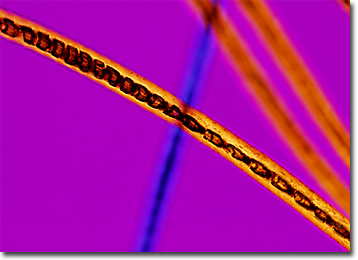Polarized Light Microscopy Digital Image Gallery
Nutria Hair
The nutria, which is sometimes alternatively known as the coypu, is an aquatic rodent native to South America. Due to escape from North American fur farms, as well as intentional introduction, however, the superb swimmer can also be found inhabiting various areas of the United States and Canada.

The general appearance of the nutria is sometimes compared to that of a beaver, although the rodent has a rounded, rather than a flattened, tail. Like the beaver, however, the limbs of the nutria are short and its body is rather stout, weighing as much as 35 pounds, although 16 to 18 pounds is more typical. The nutria also features webbing on its hind feet and large incisors, and since the mouth of the aquatic animal closes behind these sizeable teeth, the nutria can readily cut down vegetation while it is swimming without water entering into the oral cavity. Nutria fur is composed of two layers of long, coarse guard hairs, as well as a short, soft underfur, which is often utilized for commercial purposes.
Scientifically described as Myocastor coypus, the nutria is generally considered a communal animal because a single den is usually shared by a dominant male and multiple females as well as any young offspring. The entrances to these dens are typically found a foot or more under the water, although the inner cavities of the structures are located above the waterline. Grasses and other vegetation serve as bedding as well as food for the rodents, who are sometimes considered pests because their incessant feeding upon certain plants can be detrimental to ecosystems and competing organisms, such as the muskrat.
